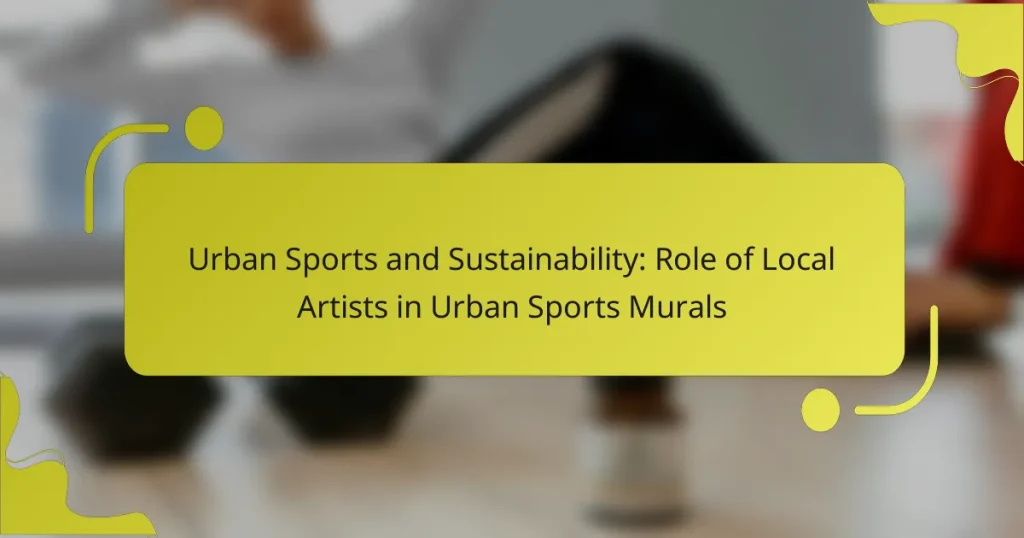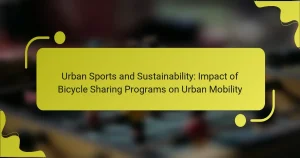Urban sports murals significantly enhance community engagement and promote sustainability in urban areas. Local artists create these murals, integrating eco-friendly materials and messages that encourage sustainable practices. They transform neglected spaces, foster pride, and inspire active lifestyles while reflecting local culture. Despite facing challenges like funding and community engagement, these artworks serve as vital platforms for collaboration between artists and athletes, ultimately benefiting local environments and businesses.
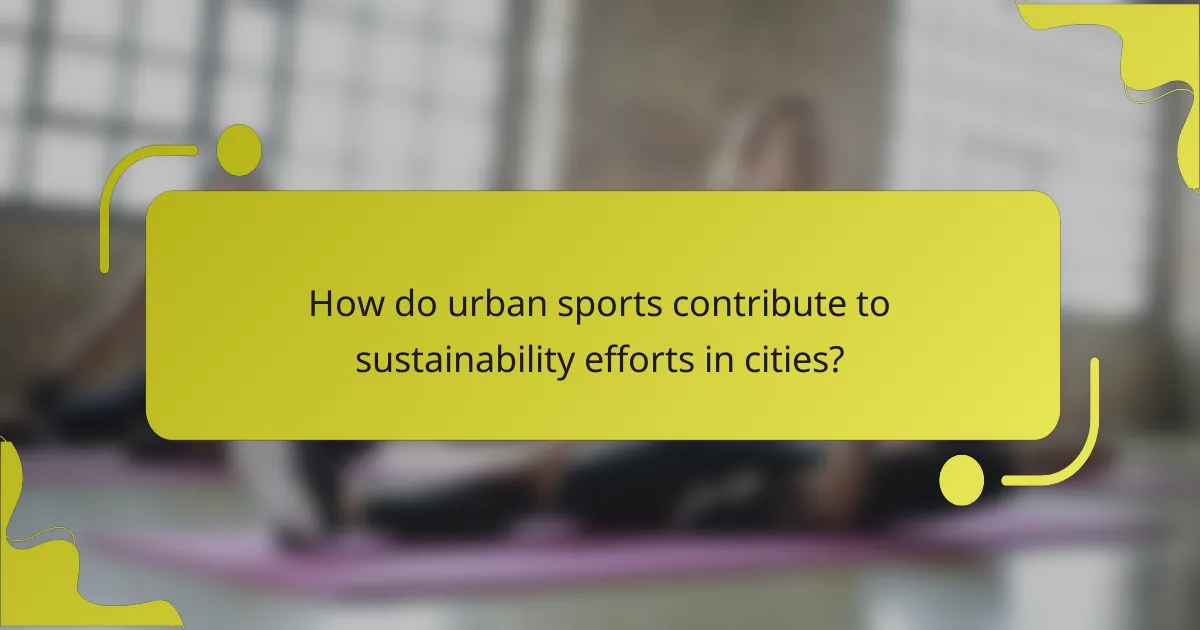
How do urban sports contribute to sustainability efforts in cities?
Urban sports contribute significantly to sustainability efforts in cities by promoting community engagement and environmental awareness. Local artists enhance this impact through urban sports murals, which serve as visual reminders of sustainability themes. These murals often incorporate eco-friendly materials and messages that encourage sustainable practices. For example, they can highlight the importance of green spaces or recycling initiatives. By beautifying urban environments, these artworks foster a sense of pride and responsibility among residents, motivating them to participate in sustainability efforts actively.
What are the environmental benefits of urban sports?
Urban sports promote environmental benefits by enhancing community engagement and encouraging sustainable practices. They transform neglected spaces into vibrant areas, fostering biodiversity and reducing urban heat. Murals created by local artists in urban sports settings not only beautify these areas but also promote awareness of environmental issues. This creative expression can inspire community action toward sustainability and environmental stewardship.
How do urban sports promote community engagement and social cohesion?
Urban sports promote community engagement and social cohesion by fostering collaboration and creativity among local artists and participants. Murals created by artists enhance public spaces, making them more inviting and visually appealing. This artistic expression often reflects the community’s identity, encouraging residents to connect with their environment. As a result, urban sports events become venues for social interaction, bridging gaps between diverse groups. Local artists play a crucial role in this dynamic, transforming ordinary spaces into vibrant hubs of activity and engagement.
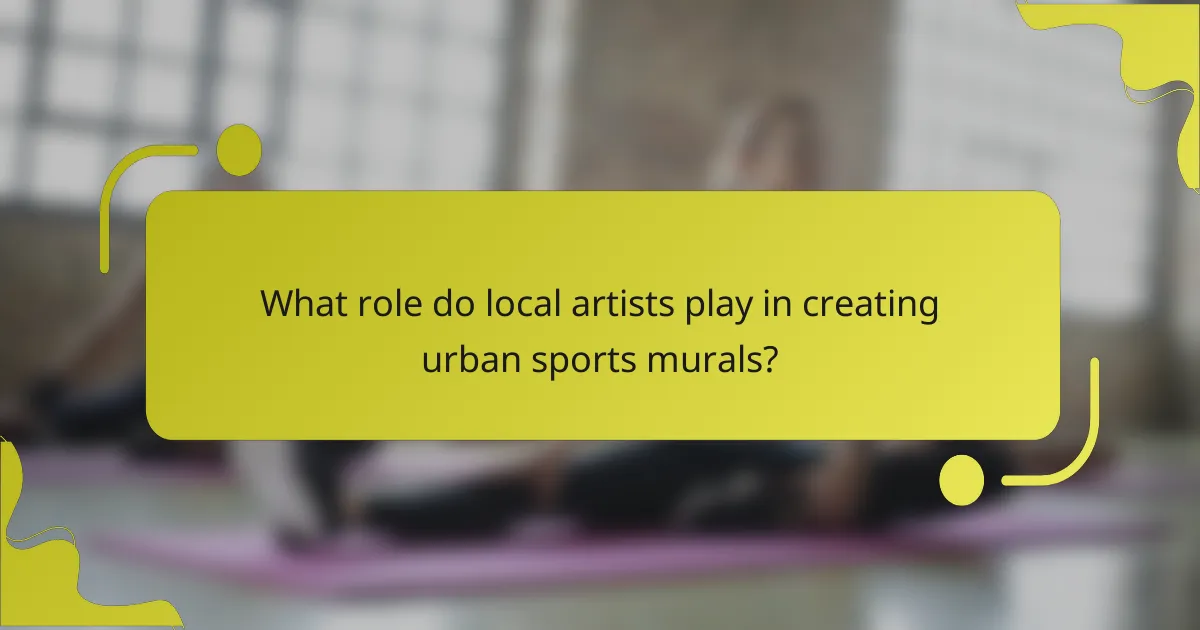
What role do local artists play in creating urban sports murals?
Local artists play a crucial role in creating urban sports murals by enhancing community identity and promoting sustainability. Their work often reflects local culture and encourages public engagement in sports and environmental initiatives. These murals can transform neglected spaces, fostering pride and revitalizing urban areas. Additionally, local artists often collaborate with community organizations to ensure the murals resonate with residents, integrating messages that inspire active lifestyles and environmental awareness. This unique attribute of local involvement makes urban sports murals more than just art; they become a vehicle for positive change and community cohesion.
How do murals enhance the visibility of urban sports?
Murals significantly enhance the visibility of urban sports by transforming public spaces into vibrant showcases. They attract attention, engage the community, and promote local sporting events. Local artists contribute unique styles that reflect the culture and energy of urban sports. This artistic expression fosters a sense of identity, making urban sports more appealing to a broader audience. As a result, murals not only beautify neighborhoods but also encourage participation and support for local athletes and events.
What are the artistic styles commonly used in urban sports murals?
Urban sports murals often feature styles like graffiti, street art, and realism. These artistic expressions emphasize movement, energy, and community engagement. Graffiti incorporates vibrant colors and dynamic lettering, while street art blends various techniques to reflect local culture. Realism captures lifelike representations of athletes, showcasing their skills and the urban environment. Each style contributes uniquely to the narrative of urban sports, fostering a sense of identity and sustainability within communities.
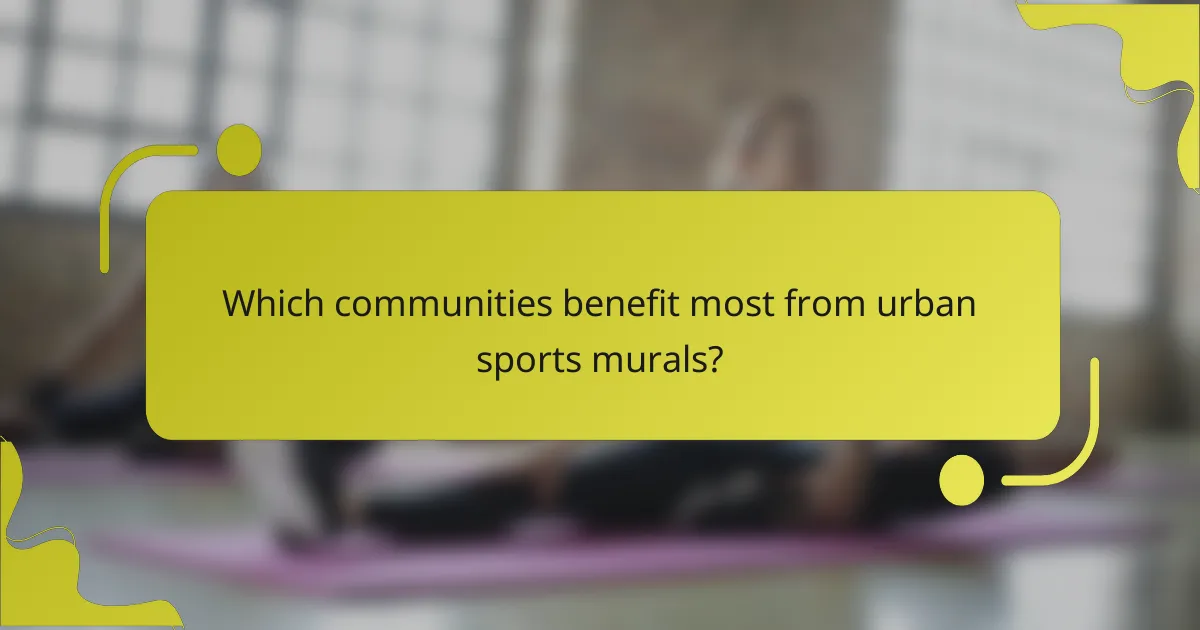
Which communities benefit most from urban sports murals?
Urban sports murals benefit communities that prioritize youth engagement, cultural expression, and local identity. These murals foster a sense of belonging and encourage physical activity. Areas with limited recreational facilities see significant positive impacts from such initiatives. Local artists contribute unique cultural narratives, enhancing community pride and cohesion.
How do murals reflect local culture and identity?
Murals reflect local culture and identity by showcasing community narratives and values. Local artists often draw inspiration from urban sports, embedding cultural symbols and stories in their work. This connection fosters a sense of belonging and pride among residents. Additionally, murals can promote sustainability by highlighting environmental themes and encouraging community engagement in urban spaces.
What impact do urban sports murals have on youth engagement?
Urban sports murals significantly enhance youth engagement by fostering community identity and encouraging participation. These artworks often depict local athletes and sports culture, inspiring young people to connect with their environment. Murals created by local artists can serve as a platform for youth expression and creativity, promoting positive social interactions. As a result, communities see increased involvement in urban sports initiatives, leading to healthier lifestyles and stronger social ties.
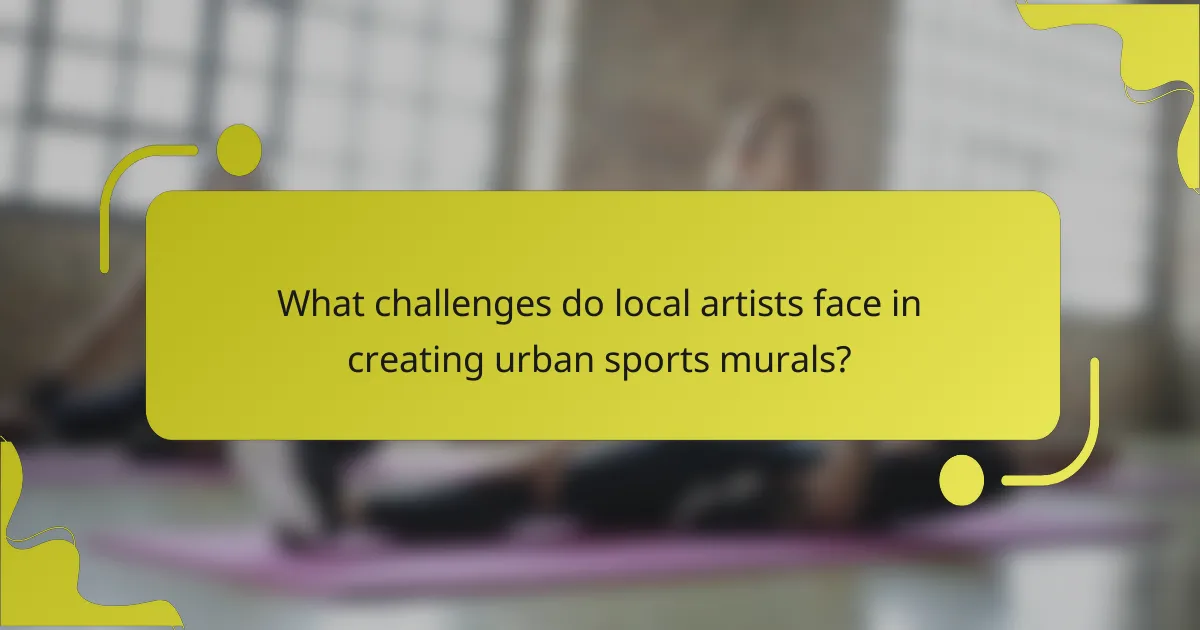
What challenges do local artists face in creating urban sports murals?
Local artists face several challenges in creating urban sports murals, including funding shortages, community engagement, and environmental factors. Limited financial resources restrict their ability to source quality materials and tools. Engaging the community is crucial for support, yet artists often struggle to connect with local stakeholders. Additionally, adverse weather conditions can hinder the mural’s longevity and affect the artist’s work schedule. These challenges impact the overall sustainability of urban sports murals and the artists’ ability to contribute effectively to urban culture.
How do funding and resources affect mural projects?
Funding and resources significantly influence mural projects by determining the scope, quality, and sustainability of the artwork. Adequate funding allows for better materials, skilled artists, and longer project durations. Local artists, when supported financially, can create more impactful urban sports murals that resonate with community values. Additionally, resources such as community engagement and partnerships can enhance visibility and support for these projects. Ultimately, the availability of funding and resources directly affects the artistic expression and community connection within urban sports murals.
What are the legal considerations for mural installations?
Legal considerations for mural installations include obtaining necessary permits, ensuring compliance with local zoning laws, and respecting copyright regulations. Artists must also consider community impact and potential liability issues. These factors contribute to the successful integration of urban sports murals into public spaces.
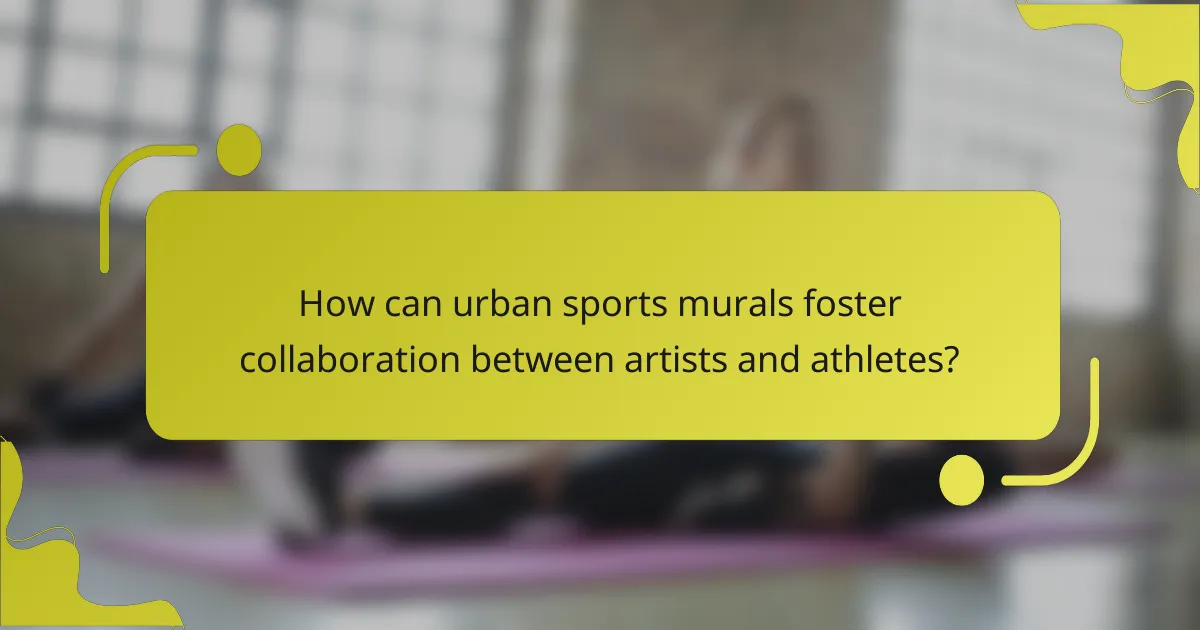
How can urban sports murals foster collaboration between artists and athletes?
Urban sports murals foster collaboration between artists and athletes by creating shared spaces for expression. These murals serve as platforms for athletes to showcase their skills while artists bring their creative visions to life. This collaboration enhances community engagement and promotes local culture. By integrating artistic elements with athletic themes, murals can inspire and motivate both athletes and spectators. Additionally, they often reflect community values, creating a sense of ownership and pride among residents.
What successful partnerships have emerged in urban sports mural projects?
Successful partnerships in urban sports mural projects often involve local artists collaborating with community organizations, schools, and sports teams. These collaborations enhance community engagement and promote sustainability in urban spaces. For instance, the partnership between local artists and youth sports programs has resulted in vibrant murals that celebrate athleticism and cultural identity. Such initiatives not only beautify neighborhoods but also foster a sense of pride and ownership among residents. Additionally, partnerships with environmental organizations have integrated eco-friendly materials into mural projects, aligning urban sports with sustainability goals.
How can community events enhance the mural creation process?
Community events significantly enhance the mural creation process by fostering collaboration and engagement. Local artists can connect with residents, gathering insights that reflect community values. This interaction leads to murals that resonate deeply with the audience, promoting local identity. Additionally, these events often attract diverse participants, enriching the artistic input and ensuring varied perspectives are represented. As a result, the murals not only beautify urban spaces but also strengthen community ties and encourage sustainable practices.
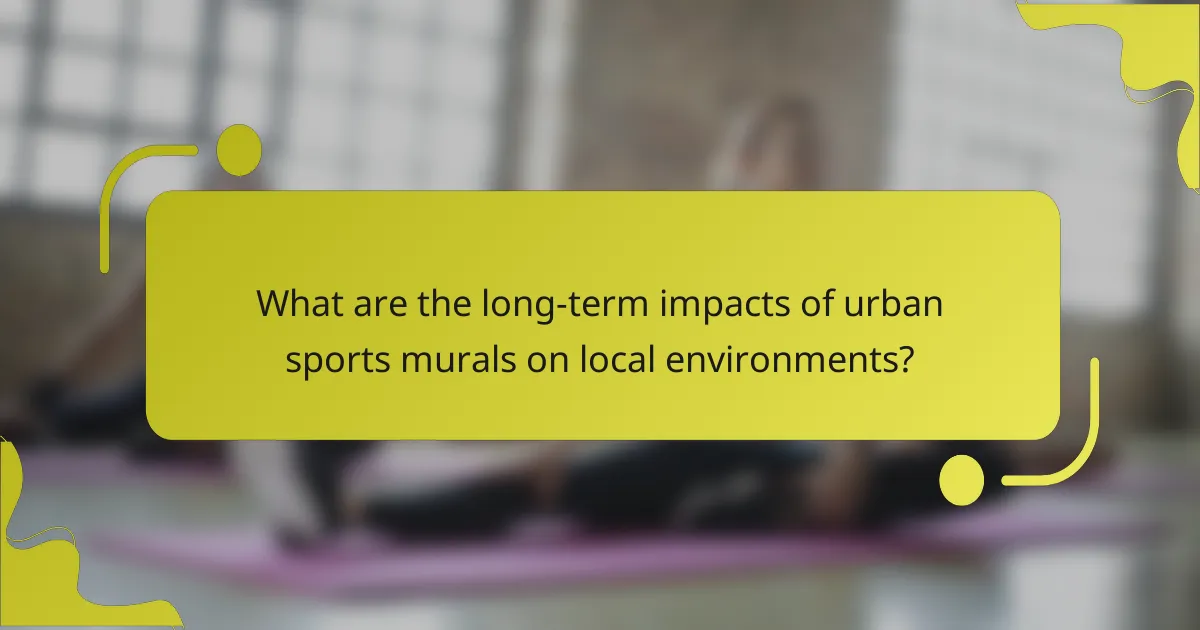
What are the long-term impacts of urban sports murals on local environments?
Urban sports murals positively impact local environments through enhanced community engagement and beautification. They foster social cohesion, encourage outdoor activity, and promote local artists. These murals can also contribute to urban sustainability by transforming neglected spaces into vibrant areas, thus reducing vandalism and promoting pride in the community. The presence of these artworks often leads to increased foot traffic, benefiting local businesses and creating a sense of ownership among residents.
How do murals contribute to urban regeneration?
Murals significantly enhance urban regeneration by fostering community identity and promoting local culture. They transform neglected spaces into vibrant public areas, attracting visitors and encouraging social interaction. Local artists contribute unique perspectives, reflecting the community’s values and aspirations. This creative expression boosts local economies by increasing foot traffic and supporting nearby businesses. Furthermore, murals often address social issues, raising awareness and inspiring change within urban environments.
What are the potential drawbacks of urban sports murals?
Urban sports murals can have drawbacks such as potential vandalism, maintenance challenges, and community backlash. These factors can undermine the intended positive impact of the murals. Vandalism may lead to additional costs for restoration. Maintenance can be resource-intensive, requiring regular touch-ups. Community backlash may arise if the murals are perceived as inappropriate or not representative of local culture.
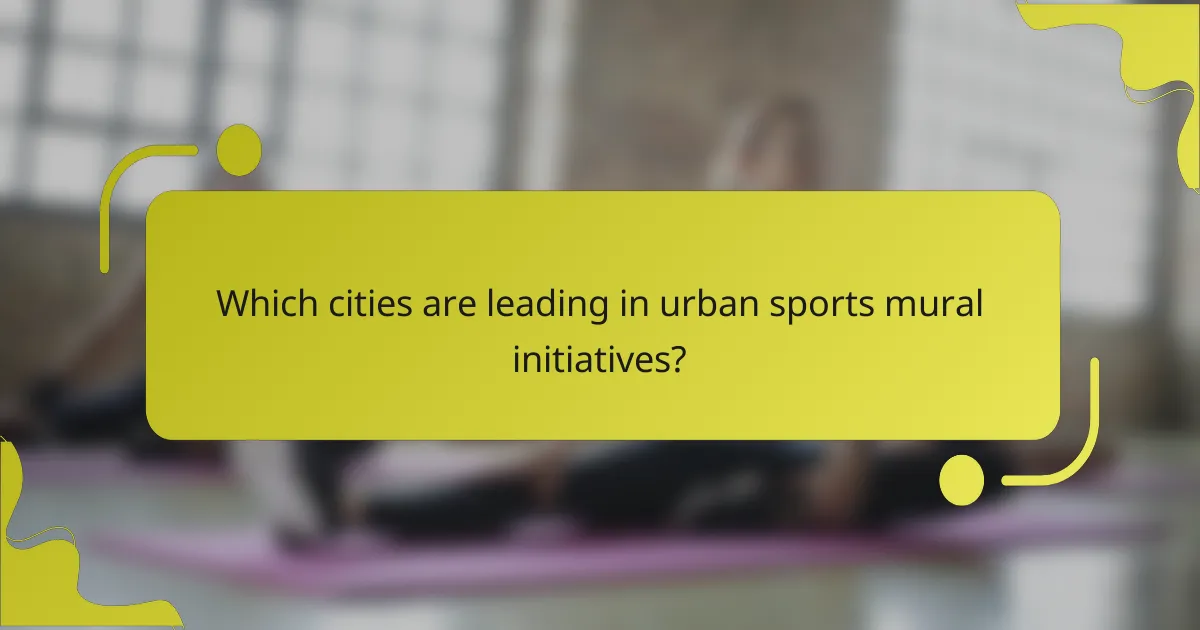
Which cities are leading in urban sports mural initiatives?
Cities leading in urban sports mural initiatives include Los Angeles, New York, Berlin, Melbourne, and São Paulo. These cities foster collaboration between local artists and communities to promote urban sports through vibrant murals.
Los Angeles embraces skateboarding culture, showcasing murals that reflect its diverse sports scene. New York features murals dedicated to basketball, enhancing public spaces and community engagement. Berlin’s murals celebrate street art and urban sports, creating a unique cultural blend. Melbourne integrates cycling and skateboarding themes into its murals, promoting sustainability. São Paulo highlights local street sports, using art to inspire youth participation.
These initiatives not only beautify urban environments but also encourage active lifestyles and community involvement.
What can be learned from successful urban sports mural programs?
Successful urban sports mural programs foster community engagement and promote local culture. They can teach valuable lessons about collaboration, creativity, and sustainability. Local artists often bring unique perspectives, enhancing the visual landscape while addressing social issues. These programs can also serve as platforms for youth involvement, encouraging participation in both art and sports. By integrating environmental themes, they raise awareness about sustainability, making art a tool for positive change.
How do cultural differences influence mural themes in urban sports?
Cultural differences significantly shape mural themes in urban sports by reflecting local values and identities. Artists often incorporate regional symbols, historical narratives, and community aspirations into their work. For instance, a mural in a city with a rich skateboarding culture may highlight local skate parks and influential skaters. This localized approach fosters community pride and engagement, making the murals resonate deeply with residents. Additionally, varying cultural backgrounds influence the choice of colors, styles, and motifs, resulting in diverse artistic expressions across urban environments.
What best practices can local artists follow for impactful urban sports murals?
Local artists can enhance urban sports murals by following best practices that emphasize community engagement and sustainability. First, collaborate with local athletes and organizations to ensure the mural resonates with the community. Incorporate eco-friendly materials and techniques, which not only reduce environmental impact but also promote sustainability. Use vibrant colors and dynamic designs to capture the energy of urban sports, making the mural a focal point that inspires action. Lastly, consider the mural’s location and visibility to maximize its impact and encourage appreciation among passersby.
